
The OFAB-100-120 is a small bomb that can be carried on Sukhoi Su-17, Sukhoi Su-25, MiG-29, Su-27, Sukhoi Su-30 and various other aircraft. [1]

The OFAB-100-120 is a small bomb that can be carried on Sukhoi Su-17, Sukhoi Su-25, MiG-29, Su-27, Sukhoi Su-30 and various other aircraft. [1]
This bomb is designed to engage lightly armored materiel and military industrial facilities, as well as manpower. [2] It is dropped from altitudes of 500 to 15,000 m at a speed of 500 to 1,150 km/h. This aircraft bomb is effective against personnel in open terrain and motorized infantry at the reserves concentration base either on the march or in battle array. It is filled with fragments and powerful explosive compositions based on TNT/RDX. The design of this aircraft bomb provides for better fragments distribution in the fragments flight area and high density of the fragmentation zone within the lethal range as compared to general-purpose munitions. [3] Aircraft can carry this bomb with a single-point suspension bomb rack or on 14” NATO standard suspension systems, using the corresponding fuze type.

The Ilyushin Il-10 was a Soviet ground attack aircraft developed at the end of World War II by the Ilyushin construction bureau. It was also license-built in Czechoslovakia by Avia as the Avia B-33.
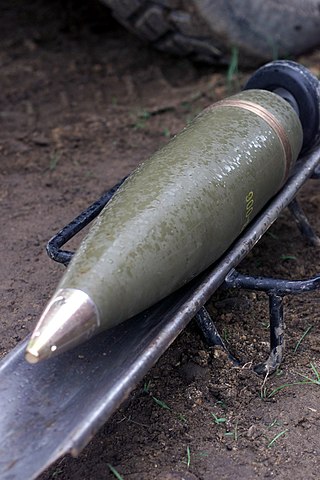
The M107 is a 155 mm high explosive projectile used by many countries. It is a bursting round with fragmentation and blast effects. It used to be the standard 155 mm high explosive projectile for howitzers of the US Army and US Marine Corps, but is being superseded in the US military by the M795.

A shell, in a military context, is a projectile whose payload contains an explosive, incendiary, or other chemical filling. Originally it was called a bombshell, but "shell" has come to be unambiguous in a military context. Modern usage sometimes includes large solid kinetic projectiles, which are more properly termed shot. Solid shot may contain a pyrotechnic compound if a tracer or spotting charge is used.

The Butterfly Bomb was a German 2-kilogram (4.4 lb) anti-personnel submunition used by the Luftwaffe during the Second World War. It was so named because the thin cylindrical metal outer shell which hinged open when the bomblet deployed gave it the superficial appearance of a large butterfly. The design was very distinctive and easy to recognise. SD 2 bomblets were not dropped individually, but were packed into containers holding between 6 and 108 submunitions e.g. the AB 23 SD 2 and AB 250-3 submunition dispensers. The SD 2 submunitions were released after the container was released from the aircraft and had burst open. Because SD 2s were always dropped in groups the discovery of one unexploded SD 2 was a reliable indication that others had been dropped nearby. This bomb type was one of the first cluster bombs ever used in combat and it proved to be a highly effective weapon. The bomb containers that carried the SD 2 bomblets and released them in the air were nicknamed the "Devil's Eggs" by Luftwaffe air and ground crew.

A general-purpose bomb is an air-dropped bomb intended as a compromise between blast damage, penetration, and fragmentation in explosive effect. They are designed to be effective against enemy troops, vehicles, and buildings.

The Sukhoi Su-9 was an early jet fighter built in the Soviet Union shortly after World War II. The design began in 1944 and was intended to use Soviet-designed turbojet engines. The design was heavily influenced by captured German jet fighters and it was subsequently redesigned to use a Soviet copy of a German turbojet. The Su-9 was slower than competing Soviet aircraft and it was cancelled as a result. A modified version with different engines and a revised wing became the Su-11, but this did not enter production either. The Su-13 was a proposal to re-engine the aircraft with Soviet copies of the Rolls-Royce Derwent turbojet as well as to modify it for night fighting, but neither proposal was accepted.
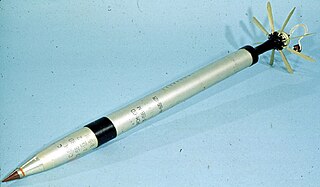
The S-5 is a rocket weapon developed by the Soviet Air Force and used by military aircraft against ground area targets. It is in service with the Russian Aerospace Forces and various export customers. It is based on the R4M, a German design from World War 2.

The Sukhoi Su-30MKM is a supermaneuverable fighter of the Royal Malaysian Air Force. It is a variant of the Su-30 series fighters, with many significant improvements over the original Su-30MK export version. The Su-30MKM was developed by the Sukhoi Design Bureau and is based on the Su-30MKI of the Indian Air Force. Both aircraft have common airframe, thrust vectoring engines and digital fly-by-wire system, however the MKM version differs from the MKI mainly in the composition of the onboard avionics. It can carry up to 8,000 kg (17,637 lb) payload over a 1,296 km un-refueled combat radius.

The Sukhoi Su-6 was a Soviet ground-attack aircraft developed during World War II. The mixed-power high-altitude interceptor Su-7 was based on the single-seat Su-6 prototype.
The Sukhoi Su-8 or DDBSh was a Soviet prototype ground-attack aircraft of World War II.

The Gryazev-Shipunov GSh-30-1 is a 30 mm autocannon designed for use on Soviet and later Russian military aircraft, entering service in the early 1980s. Its current manufacturer is the Russian company JSC Izhmash. The name GSH-30-1 is formed from the surnames of the designers Gryazev (Грязев) and Shipunov (Шипунов), the caliber of 30 mm and the single-barrel design of the gun itself.

The FAB-500 is a Soviet-designed 500-kilogram (1,100 lb) general purpose air-dropped bomb with a high-explosive warhead, primarily used by the Russian Aerospace Forces, former Soviet republics and customer countries. The original M-54 model was rolled out in 1954, shaped for internal carriage by heavy bombers, a low-drag M-62 version in 1962 was intended for fighter bomber external hardpoint carriage. The bomb is unguided, features a single nose fuze, and is compatible with most models of Soviet aircraft.

The SD 50 or thick walled explosive bomb in English was a fragmentation bomb used by the Luftwaffe during World War II.

The SD 70 or thick walled explosive bomb in English was a fragmentation bomb used by the Luftwaffe during World War II.
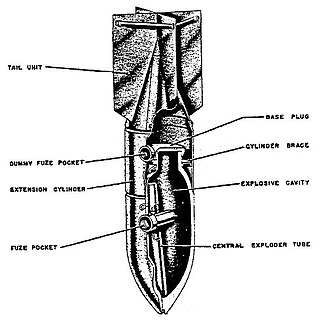
The SD 250 or thick walled explosive bomb in English was a fragmentation bomb used by the Luftwaffe during World War II.
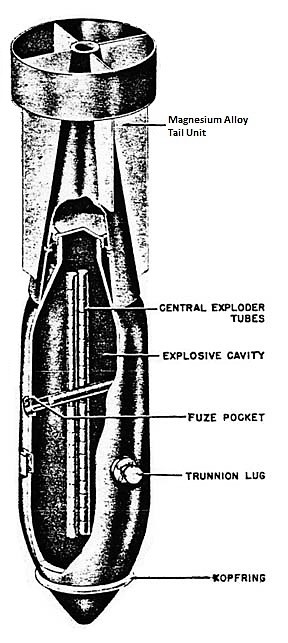
The SD 1700 or thick walled explosive bomb in English was a fragmentation bomb used by the Luftwaffe during World War II.
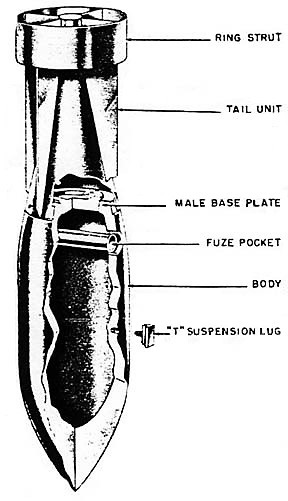
The PC 500 or cylindrical armor-piercing explosive bomb in English was a series of armor-piercing bombs used by the Luftwaffe during World War II.
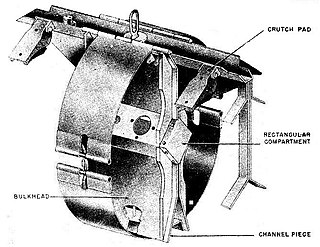
The AB 500-3A(Abwurfbehälter) was a cluster bomb used by the Luftwaffe during World War II.
The High Speed Low Drag (HSLD) bomb is a family of new generation short range air-dropped precision-guided munition that is currently being developed by India's Defence Research and Development Organisation (DRDO). This general-purpose bomb is made for the Indian Air Force (IAF) and can be used against the destruction of strategic high value enemy infrastructure from stand-off distances. HSLD is comparable to Mark 80 series of bombs used by United States Air Force (USAF).
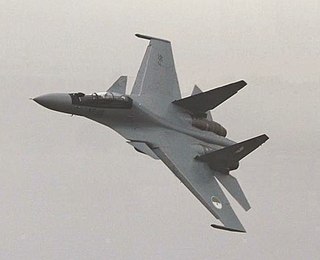
The Sukhoi Su-30MKA is a twinjet multirole air superiority fighter developed by Russia's Sukhoi made for the Algerian Air Force. A variant of the Sukhoi Su-30, it is a heavy, all-weather, long-range fighter. The aircraft is based on the Indian Sukhoi Su-30MKI and is the 2nd adaptation of the same, after the first one being the Malaysian Sukhoi Su-30MKM.